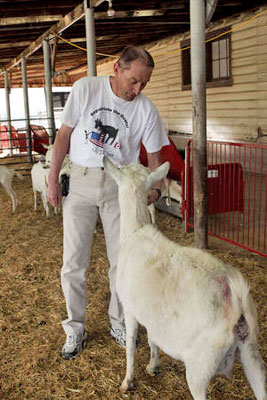|
from
NaturalSociety Website
Scientists are now discussing the possibility of adding silk-producing spider genes into the human genome to produce ‘bulletproof’ skin.
The news comes after testing was done on bioengineered human skin that was grown in a laboratory and mixed with ‘milk’ created from a genetically engineered ‘spider goat‘.
This is a goat that has been genetically tweaked to produce the same
protein found in spider silk. Spider goats are transgenic creations
that have two key spider genes embedded into their genetic code that
enable them to weave extremely strong silk.
The silk is actually 5 times stronger than steel, and is one of the strongest fibers known to man.
While the fibers involved with the creation of the bulletproof skin are not as strong, they are still extremely powerful. It sounds like something out of a science fiction novel, but Dutch scientist Jalila Essaidi says it will soon be a reality.
While she performed tests involving the silk-embedded bulletproof skin vest created in the lab, she discussed the very real possibility of actually replacing human skin proteins with that of a spider.
She said:
The lab-grown skin fused with the ‘silk’ is currently capable of withstanding a direct impact from a bullet fired below full speed. Researchers say that the ‘transhumanistic’ idea of the silk vest could make science fiction a reality.
View the video of the testing:
-
Spider Goat Silk to Make ‘Bulletproof Human
Skin’ -
Following the leaked news that scientists have created 15,000+ experimental animal hybrids, it has now come out that researchers are in the process of developing bulletproof human skin by using the silk of a creature with both spider and goat genes known as a spider goat.
Spider goats are transgenic creations that have two key spider genes embedded into their genetic code that enable them to weave extremely strong silk.
Utah State researchers are now in the
process of utilizing the spider goat silk in a “bio-art” project
that aims to create artificial tendons and ligaments that are
completely bulletproof.
While the fibers involved with the creation of the bulletproof skin are not as strong, they are still extremely powerful.
Researcher Randy Lewis, the creator of spider goats, teamed up with Dutch artist Jalila Essaidi to conduct an experiment weaving a lattice of human skin cells and silk that was capable of stopping bullets fired at reduced speeds.
The results were shocking, with the silk-laced artificial skin withstanding the impact of a bullet.
The troubling nature
of this research While there are plenty of positive aspects to this research, there are also a number of troubling factors.
We have seen the result of genetically modified foods, with studies detailing how they devastate your health. As the genetic modification of the planet continues, the very genetic coding of the world is threatened.
From crops to living creatures, genetic
modification has run rampant. This report shows that humans may be
next on the list, with the military eyeing up the bulletproof human
skin made from spider goat silk to use for combat.
...Create
One of the Strongest Known Substances
from
DeseretNews Website
Utah researcher uses goats to make
one of the strongest known substances
Utah State University (USU) professor Randy Lewis’s goats look and behave like most other goats:
But these goats could hold the key to
revolutionizing everything from tendon replacements and stronger
parachutes to safer airbags.
His work has been featured in top
science journals as well as National Geographic and Time magazines.
He was also featured on PBS’s NOVA and the Discovery Channel. He has
been featured on European television and more recently in Canada.
USTAR is a long-term, state-funded program that invests in science research with innovation and commercial potential. Researchers and biochemical companies have long thought spider silk to be an ideal material for countless applications. It’s stronger than steel and as stretchy as nylon.
But milking and caring for them is much easier than working with spiders.
It took about 80 people four years to harvest enough spider silk to weave a half-million-dollar golden tapestry.
The 11-by-4-foot tapestry was displayed
at the New York Museum of Natural History in 2009. Made by artists
in Madagascar, the threads were harvested from over a million
spiders, according to the museum. The tapestry is only one of two
spider silk textiles known in the world.
So he settled on goats.
Initially Lewis teamed up with a Canadian company that produced the first goats.
Unfortunately, the company went under and Lewis’s team was stuck with a problem.
Currently the herd of special goats is
at about 36.
Lewis has managed to gain $3.2 million in research grants and was recently awarded another $40,000 from the state in a Technology Commercialization and Innovation Program grant.
His technology has also gained the interest of,
Lewis’s goats are milked about twice a day; however, there are a lot of other components from the milk that need to be removed in order to isolate the two key proteins that make spider silk.
The goats are separated into two groups,
each group contains one of the two proteins to make the silk, so the
proteins must be extracted and then combined.
A smaller, more refined, filter then further isolates the silk proteins.
Still, the challenge remains: how do
they take a powder and spin it into a fiber, like a spider does?
On average, spiders can spin six different types of fibers with various properties.
Lewis’ team has managed to spin a fiber similar to a spider’s suspension line, which is the thicker of the fiber types. The two proteins are combined into a solution and pushed into a needle, but a spider pulls the silk out of its spinners, where a syringe would push it out.
So lab workers tease the silk out of the needle and then pull it out like a spider.
What they get is a fiber that is incredibly strong, amazingly light-weight and very versatile.
In current medicine, doctors takes a torn ligament or tendon and carefully sew it together, providing a less-than-durable treatment.
Lewis said silk is very compatible with the human body and can be used as temporary tendons and ligaments while providing a scaffolding for the body to begin healing the tear together.
Silk can also be used to suture damaged
eyes, or even nerves.
Lewis said one feature of spider silk is
that it absorbs energy better. Current air bags can knock children
and adults back into their seats when deployed, causing possible
injury. Lewis said studies show spider silk appears to better absorb
energy and would minimize such knock-back.
|



